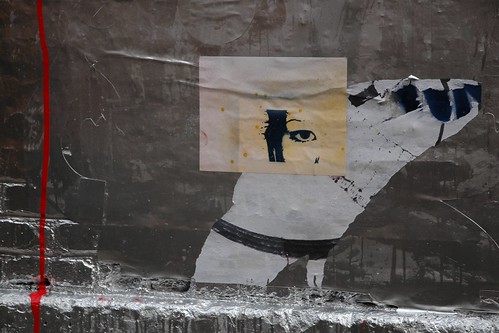
this collage is probably mostly an accident, but stunning nevertheless
[for 41 more images go to my 11 Spring photo set]
Why is it called "street art"? And does art created in the street step out of character when it steps in off the street? Where does street art fit in the hierarchy? Can street art inform the mostly housebroken art which makes it into our galleries, our homes, our museums? Does street art disappear when the street moves on? What role does commerce play in the creation and the survival of art seen in the street - or the survival of the privileged art of the salon? Is street art necessarily more political than art which originates under a roof? Can just about anyone appreciate, can everyone learn to love, the best art found on the streets? Why does street art attract a special kind of excitement, even fanaticism and almost cultish devotion to its mysteries and beauties that is almost never shared by conventional art museums? Does an artist have to love a street before she or he can use it as a "canvas"? Is there a future for street art in an increasingly-sanitized Manhattan, and nearby Brooklyn, rapidly being customized for the pleasure of millionaires and their vastly richer new neighbors?
This past weekend New Yorkers had a rare and wonderful opportunity to be provoked by at least some of these questions, and probably a lot more I left out, so long as they were willing to stand in line (yes, in the street) for an hour and probably much longer in order to gain access to the cultural and real estate phenomenon of "Wooster on Spring". Well, admittedly the line was for a view of inside street art (inspiring some of the questions posed in the paragraph above), but the experience was almost like stepping inside the work itself. The fact that all of the art would soon be rendered invisible obviously added to the appeal of this temporary street-corner agora. 11 Spring Street is now closed and construction will soon begin on the five floors of this nineteenth-century brick and stone building in NoLIta. The grim but noble pile is slated for conversion into another representative of New York's still growing stash of "luxury condos".
Me, I really liked the art, but I couldn't also help thinking of the significance of this amazing phenomenon while trying to decode and enjoy the exciting work of the 45 artists who were invited and hosted over the last few months by a few other people who clearly like art - a whole lot.
And now it's all gone. Well, at least until the next New York renaisance, for while the outside of the building is to be cleaned and restored to something like its nineteenth-century appearance, the work inside 11 Spring is to be sealed up for the ages behind the new plasterboard walls deemed meet for the pampered sheltering of our newest professional class. If things work out better than they do in most apartment buildings, eventually there will at least be some good art showing up on those clean white walls, even if it will have to be store-bought.
I have not put captions on the Flickr images, largely because many are general or detail installation shots and because I'm not able to identify most of the artists. I'd be delighted if more knowledgeable visitors to the site could add attributions with their comments.
I love how the streets 'n' walls of buildings are used as canvases for the mixed media, which I look at as hands-on photoshopped work. I'd love to visit the city 'n' check these works in public.